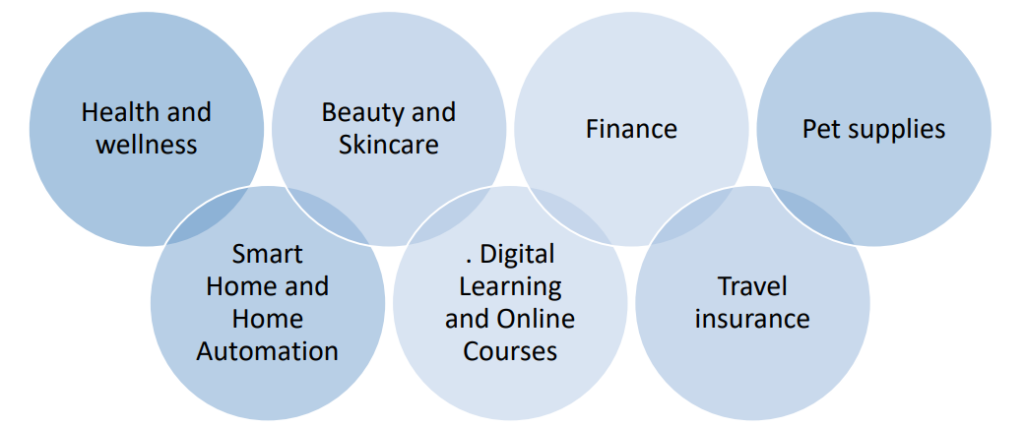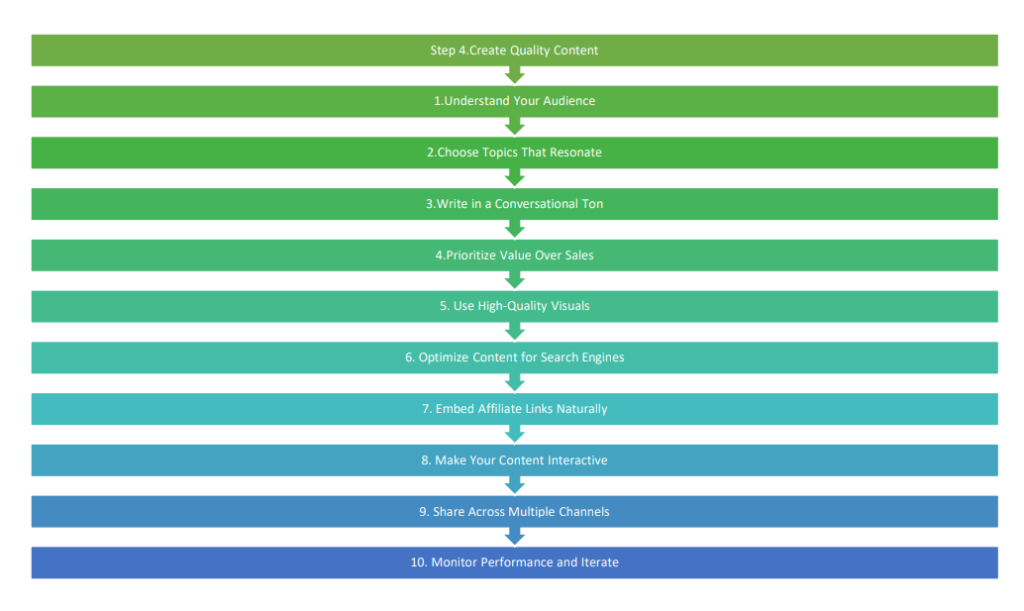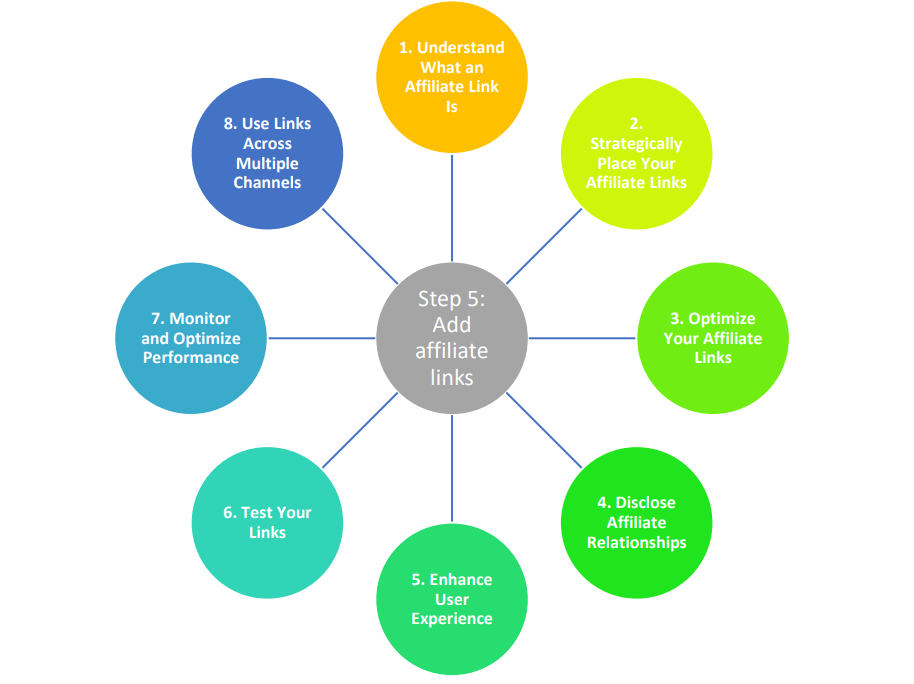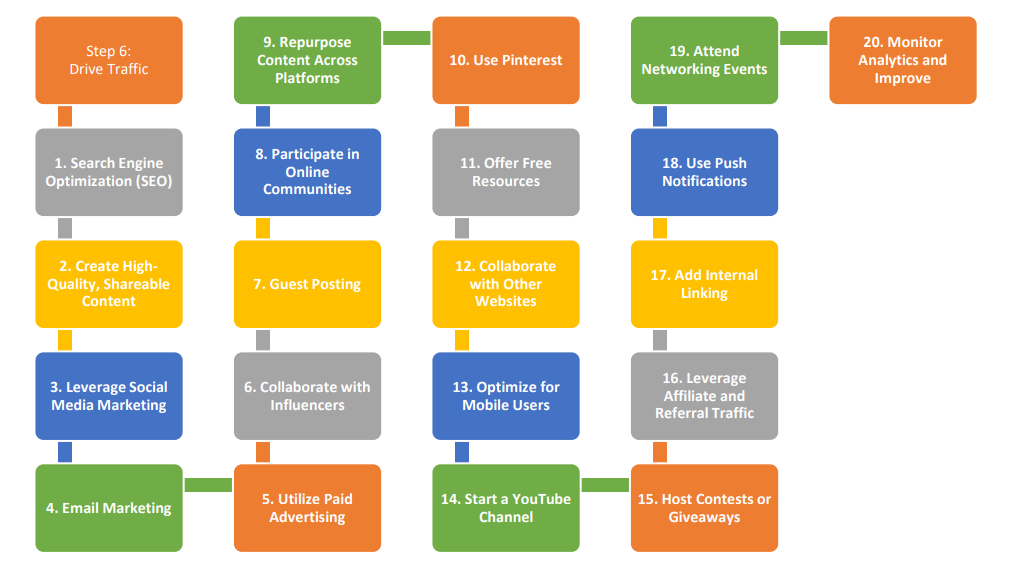Everyone wants to achieve financial independence at an early age, and I believe it’s crucial to start building your path to success. In today’s fast-paced world, leading your own life and pursuing your dreams has never been more important. That’s why I’m here with innovative ideas to help you take control of your future. Stay connected with EagleGravity, where we’re ready to propel you to heights beyond imagination—breaking limits and reaching beyond the gravity of ordinary success. Together, let’s soar toward your dreams.
Affiliate marketing is a business model where you promote another company’s product, and when someone makes a purchase through your unique link, you earn a commission.
Simply put, affiliate marketing is an excellent source of income for everyone. Once you understand the entire concept of affiliate marketing, it becomes easier to become an affiliate.

A Roadmap to Affiliate Marketing
Here is a basic overview or roadmap for affiliate marketing. By following these steps, you can start your journey as an affiliate marketer.
Step 1: Purchase a Domain and Hosting
To begin affiliate marketing, you first need to build a website. This requires purchasing a domain name and web hosting.

– Domain: Your domain name is the address of your website. Choose a name that is relevant to your niche and easy to remember.
– Hosting: Web hosting is essential for making your website accessible on the internet. Hostinger is a popular choice among marketers because it is reliable and affordable. For beginners, I recommend Hostinger for its affordability and user-friendly features.
Discount Tip: Use my 10% discount by using this link to save on web hosting and domain registration!
Link: https://cart.hostinger.com/pay/34d1d486-9a49-4cc5-a771-a1dd7c912932?_ga=GA1.3.942352702.1711283207 or ZISHA10.
Step 2: Choose a Niche
A niche is a specialized area or topic. Selecting a niche is crucial as it helps you stand out in the competitive field of affiliate marketing.

– Why Niche is Important:
– It helps with SEO (Search Engine Optimization) of your website.
– It attracts more clicks and views.
– It allows you to target a specific audience effectively.
For example:
– Main category: Fashion
– Subcategory: Jewelry
– Niche: Bracelets
Choose a niche based on your interests and expertise. Always remember the principle: What you give is what you get. Provide the best products and services to your audience. Avoid promoting products that you wouldn’t personally use or trust.
Recommended Niches for Affiliate Marketing
Here are some popular and profitable niches:
1. Health and Wellness
This evergreen niche caters to people looking to improve their health, fitness, and overall well-being. Products you can promote include:
– Fitness guides
– Weight loss programs
– Health products
– Healthy foods
2. Smart Home and Home Automation
As smart gadgets become more prevalent, many people are automating their homes. Products you can promote include:
– Home security systems
– Smart lighting
– Voice assistants
– Climate control devices
3. Beauty and Skincare
This daily necessity has a wide market. Promote products that are organic and safe for skin, such as:
– Makeup products
– Haircare items
– Skincare solutions
4. Digital Learning and Online Courses
With the rise of AI and technology, people are continuously learning new skills. Promote:
– Coding courses
– Marketing courses
– Photography courses
5. Finance
The finance niche is highly profitable due to its evergreen demand. Products you can promote include:
– Credit cards
– Insurance
– Loans
– Investment platforms
Additional Niches to Explore
Here are some other niches you can consider:
– Personal finance tools
– Cybersecurity software
– Meditation apps
– Travel insurance
– Online gaming accessories
– Luxury watches
– Sustainable living products
– Pet supplies
– Real estate platforms
– Freelancing platforms
– E-commerce platforms
– Blogging resources
– Self-help books
Final conclusion:
Take your time to research your niche thoroughly. Select one that aligns with your passion and offers value to your audience. A well-chosen niche can help you build trust and credibility, leading to long-term success in affiliate marketing.
Step 3: Select an affiliate program:
Many affiliate programs are available in the market, each offering different services. Let’s understand this with an example:
If you choose the fashion niche and focus on professional wear, look for companies that specialize in this category. Check if they have an affiliate program, analyze their commission structure, and evaluate the quality of their products. This will help you decide which program is most beneficial for you.

1. Major Retailers with Affiliate Programs:
These retailers offer a wide variety of professional wear and are well-suited for affiliate marketers targeting a broad audience:
Amazon Associates: One of the largest affiliate networks, it provides a broad selection of professional wear brands. It’s ideal for beginners due to its ease of use and global reach.
Myntra Affiliate Program (India): Focuses on formal and business attire, offering a wide range of styles at various price points.
Nordstrom Affiliate Program: Caters to high-end buyers with premium professional wear options, making it suitable for niche markets.
Macy’s Affiliate Program: Features both mid-range and luxury business attire, appealing to a diverse audience.
2. Brand-Specific Affiliate Programs
These programs are run directly by clothing brands, offering unique opportunities for niche marketing:
Calvin Klein: Known for its stylish and sophisticated professional wear.
H&M: Affordable formal and semi-formal options for budget-conscious buyers.
Banana Republic: Offers high-quality, elegant business attire.
Tommy Hilfiger: Provides premium clothing that blends professionalism and style.
3. Niche Platforms
Platforms focused exclusively on workwear or sustainable options:
Stitch Fix Affiliate Program: Offers curated fashion services tailored specifically to professionals.
ThredUp Affiliate Program: Focuses on sustainable, second-hand professional clothing, appealing to eco-conscious consumers.
Workwear Express: Specializes in business attire and uniforms, ideal for companies and organizations.
4. Affiliate Networks
These networks simplify managing multiple affiliate programs in one place:
ShareASale: Features a variety of brands, including those specializing in professional wear.
CJ Affiliate (formerly Commission Junction): Includes programs for renowned brands like J.Crew and Lands’ End.
Rakuten Marketing: Provides access to global brands and offers excellent tracking and support tools.
Step 4: Create Quality Content:
Creating quality content for affiliate marketing is essential to building trust, attracting your audience, and increasing conversions. Here’s a humanized, step-by-step guide to help you craft engaging, relatable, and effective affiliate marketing content.

1. Understand Your Audience
Creating quality content begins with knowing who you’re speaking to.
– Define Your Audience: Think about their needs, preferences, and pain points. Are they professionals looking for affordable office wear or executives seeking premium brands?
– Empathize with Their Journey: Put yourself in their shoes. For example, someone preparing for their first job interview may feel overwhelmed. How can you simplify their experience?
— Use tools like surveys, social media polls, or forums to understand your audience better.
2. Choose Topics That Resonate
Your content should address your audience’s specific problems or interests.
Ideas for Topics:
– “How-To” Guides: “How to Dress for a Corporate Job Interview”* or “How to Build a Capsule Wardrobe for Work”
– Product Comparisons: “Top 5 Budget-Friendly Professional Wear Brands” vs. “Luxury Brands for Business Attire.”
– Lists and Recommendations**: “10 Must-Have Items for Office Wear in 2024.
– Real-Life Stories: Share relatable anecdotes or case studies. For instance, talk about how dressing professionally boosted someone’s confidence at work.
— Use SEO tools like Google Trends or AnswerThePublic to discover trending topics.
3. Write in a Conversational Ton
Make your content feel like a chat with a friend rather than a lecture.
Tips for Conversational Writing:
– Use personal pronouns like “you” and “we.”
– Break down complex ideas into simple, relatable language.
– Add light humor or anecdotes to keep the tone friendly.
Example:
Instead of writing:
“Professional attire is crucial for making a positive first impression in corporate environments.”
Try:
“Let’s be real—your outfit speaks before you do. Want to ace that first impression? Let’s talk professional wear.”
4. Prioritize Value Over Sales
Avoid being overly promotional. Focus on helping your audience make informed decisions.
Add Value Through:
– Product Reviews: Offer honest opinions about the pros and cons of products.
– Practical Tips: Suggest styling tips or hacks, like how to accessorize a plain blazer.
– Solutions: Recommend products that solve specific problems, like comfortable heels for long workdays.
Example:
Instead of:
“Buy this suit—it’s the best!”
Say:
“If you’re looking for a suit that balances style and comfort for long meetings, this option is worth considering.”
5. Use High-Quality Visuals
Visual content grabs attention and helps convey your message effectively.
Types of Visuals:
– Photos: Show products in real-life scenarios, like someone wearing a blazer at a meeting.
– Infographics: Create visual style guides or comparisons, e.g., *“Casual vs. Formal Office Wear.”
– Videos: Share tutorials, product unboxings, or outfit ideas.
— Invest in good lighting and a clean background for your visuals, or use tools like Canva to create professional graphics.
6. Optimize Content for Search Engines
To reach more people, ensure your content is discoverable online.
SEO Best Practices:
– Keyword Research: Use tools like Ubersuggest or SEMrush to find keywords your audience searches for (e.g., “affordable business attire”).
– Catchy Headlines: Write engaging titles like *“Dress Like a CEO: Affordable Professional Wear You’ll Love.”
– Meta Descriptions: Summarize your content in 1–2 sentences for search engines.
– Internal Links: Link to related content on your site to improve navigation and SEO.
7. Embed Affiliate Links Naturally
Your affiliate links should feel like a helpful suggestion, not a pushy sales pitch.
Examples of Natural Embedding:
– “This blazer by [Brand Name] not only fits perfectly but is also budget-friendly. Check it out here!”
– “Need a versatile pair of shoes for work? These [Brand Name] loafers are a lifesaver.”
— Always disclose your affiliate relationship to maintain trust, e.g., “This post contains affiliate links. I may earn a commission if you make a purchase at no extra cost to you.”
8. Make Your Content Interactive
Interactive content keeps your audience engaged and builds trust.
Ideas:
– Quizzes: “What’s Your Ideal Professional Style?”
– Polls: “Which outfit do you prefer for a presentation?”
– Surveys: Ask for feedback on products or topics.
9. Share Across Multiple Channels
To maximize reach, distribute your content through various platforms.
Platforms to Use:
– Blog: For long-form, detailed content like reviews and guides.
– Social Media: Use Instagram for visuals, LinkedIn for professional insights, and Pinterest for outfit boards.
– Email Newsletters: Share exclusive deals and curated recommendations with your subscribers.
— Tailor your content for each platform. For instance, Instagram might focus on visuals, while LinkedIn might feature text-heavy, professional advice.
10. Monitor Performance and Iterate
Track how your content is performing and make improvements based on data.
Metrics to Track:
– Click-Through Rates (CTR): See how many people click your affiliate links.
– Conversion Rates: Measure how many clicks lead to purchases.
– Engagement: Monitor comments, shares, and likes.
— Use analytics tools like Google Analytics or the affiliate program’s dashboard to track performance.
Finally,
Quality content for affiliate marketing is about creating trust, adding value, and connecting with your audience. By understanding their needs, being authentic, and focusing on helpful solutions, you can build a loyal following that translates into consistent affiliate income.
Step 5: Add affiliate links
Affiliate marketing is a business model where you promote another company’s product, and when someone makes a purchase through your unique link, you earn a commission.
Simply put, affiliate marketing is an excellent source of income for everyone. Once you understand the entire concept of affiliate marketing, it becomes easier to become an affiliate.Simply put, affiliate marketing is an excellent source of income for everyone. Once you understand the entire concept of affiliate marketing, it becomes easier to become an affiliate.

1. Understand What an Affiliate Link Is
An affiliate link is a unique URL provided by an affiliate program that tracks clicks and purchases. When someone uses your link to buy a product, you earn a commission.
Components of an Affiliate Link:
- Tracking ID: A unique identifier that attributes the sale to you.
- Destination URL: The product or landing page you’re directing your audience to.
Example:
https://example.com/product?ref=yourtrackingID
2. Strategically Place Your Affiliate Links
Your links should feel like a natural part of your content and not overly promotional. Here are some common placements:
a. Within Blog Posts
- Insert links where they are contextually relevant.
- Example:
“For budget-friendly yet stylish professional wear, check out [Brand Name](affiliate link).”
b. Product Reviews
- Add the link in the introduction, within the review, and at the end as a call-to-action.
- Example:
“This Banana Republic blazer offers comfort and style. [Shop Now](affiliate link).”
c. Comparison Tables
- Use tables to compare features, prices, and ratings of products, with affiliate links in the “Buy Now” column.
d. Social Media Posts
- Add your affiliate link in captions or use tools like Linktree to organize multiple links in your bio.
- Example:
“Elevate your office look with this classic blazer. Get yours here: [Affiliate Link]”
e. Email Newsletters
- Include affiliate links in your emails, but focus on adding value first.
- Example:
“Here are my top picks for professional wear this season. [Affiliate Link]”
f. YouTube Descriptions
- Add affiliate links in the video description box.
- Example:
“Find all the products mentioned in this video here: [Affiliate Link].”
3. Optimize Your Affiliate Links
a. Use Link Shorteners or Cloaking Tools
- Long, messy URLs can look unprofessional. Use tools like Bitly or Pretty Links (for WordPress) to shorten or cloak your affiliate links.
- Example:
Original:
https://example.com/product?ref=12345trackID
Shortened:
https://yoursite.com/go/professionalwear
b. Add UTM Parameters
- If you want to track which links perform best, append UTM parameters to your URLs.
- Example:
https://example.com/product?ref=yourtrackingID&utm_source=blog&utm_medium=review
4. Disclose Affiliate Relationships
Transparency is key to building trust and complying with legal requirements (like FTC guidelines).
How to Disclose:
- Add a disclaimer at the top of your content.
Example:
“This post contains affiliate links. If you make a purchase through these links, I may earn a commission at no additional cost to you.” - Mention it casually in the content.
Example:
“I’ve personally tried these products, and I only recommend what I truly love. [Affiliate Link]”
5. Enhance User Experience
Make it easy for your audience to click and trust your affiliate links.
Tips for Better UX:
- Use clear and compelling Call-to-Actions (CTAs).
Example:
“Shop now for 10% off using this [special link](affiliate link).” - Avoid overloading: Don’t overwhelm users with too many links in a single post.
- Highlight exclusive deals or discounts in bold to draw attention.
6. Test Your Links
Before publishing, ensure your affiliate links are working correctly:
- Click Test: Click the link to verify it redirects to the correct page.
- Mobile and Desktop Testing: Test on different devices for compatibility.
- Affiliate Dashboard Check: Confirm clicks and purchases are being tracked properly.
7. Monitor and Optimize Performance
Tracking your affiliate links’ performance helps you understand what works and refine your strategy.
Tools for Monitoring:
- Affiliate Program Dashboard: Most affiliate programs provide analytics on clicks, conversions, and earnings.
- Google Analytics: Use UTM parameters to track traffic sources.
- Link Management Tools: Platforms like Pretty Links or ThirstyAffiliates help track individual link performance.
Optimization Strategies:
- Replace underperforming links with better offers.
- Focus on high-performing products by creating more content around them.
- A/B test CTAs and placements to find what resonates most with your audience.
8. Use Links Across Multiple Channels
Repurpose your affiliate links across platforms for maximum reach:
- Blogs and Articles: Embed links in reviews, tutorials, and guides.
- Social Media: Share affiliate products in Instagram stories, Facebook posts, and TikTok videos.
- Emails: Create exclusive offers or curated product lists with affiliate links.
- Videos: Use affiliate links in YouTube descriptions or pinned comments.
Example Execution
Let’s say you’re promoting a Banana Republic blazer through their affiliate program.
- Write a Blog Post:
“5 Essential Pieces for Every Professional’s Wardrobe.”
Include the affiliate link as:
“This [Banana Republic blazer](affiliate link) is versatile, stylish, and perfect for any office setting.” - Share on Instagram:
Post a styled image of the blazer with the caption:
“Upgrade your office wardrobe with this chic blazer! Shop here: [Affiliate Link]” - Add to Newsletter:
Send an email with the subject: “My Top Picks for Professional Wear.”
In the body: “This blazer has been a game-changer for my meetings. [Shop it here](affiliate link).”
Short tricks :
- Place affiliate links strategically to enhance your content without being overly promotional.
- Shorten or cloak links to maintain professionalism.
- Always disclose affiliate relationships to build trust.
- Test and track link performance to improve your strategy.
By embedding your affiliate links naturally and optimizing their placement, you can create a seamless experience that benefits both your audience and your earnings. Let me know i you’d like help implementing these strategies!
Step 6: Drive traffic
Driving traffic to your website or blog is critical for the success of your affiliate marketing or online business. Here are multiple effective ways to attract visitors:

1. Search Engine Optimization (SEO)
Optimize your website to rank higher on search engines like Google.
- Keyword Research: Use tools like Google Keyword Planner, Ahrefs, or SEMrush to find high-volume, low-competition keywords relevant to your niche.
- On-Page SEO: Optimize meta titles, descriptions, and header tags. Use keywords naturally within your content.
- Off-Page SEO: Build backlinks from authoritative sites through guest posting, outreach, and collaborations.
- Technical SEO: Improve site speed, ensure mobile responsiveness, and fix broken links.
2. Create High-Quality, Shareable Content
Content that provides value is more likely to be shared and drive traffic.
- Write how-to guides, listicles, and tutorials.
- Publish content in multiple formats, like videos, infographics, and blogs.
- Keep the content engaging, accurate, and visually appealing.
3. Leverage Social Media Marketing
- Platforms: Focus on platforms where your audience spends time, such as Instagram, Facebook, LinkedIn, or Pinterest.
- Share Consistently: Post regular updates about new blogs, product reviews, and tips.
- Engage with Your Audience: Reply to comments, participate in groups, and use polls to foster interaction.
- Hashtags: Use relevant hashtags to improve discoverability.
4. Email Marketing
Build and nurture an email list to drive recurring traffic.
- Offer a free resource (e.g., eBook, checklist) to encourage email sign-ups.
- Send newsletters with links to your latest blog posts or affiliate deals.
- Personalize email content to increase engagement and click-through rates.
5. Utilize Paid Advertising
Invest in ads to reach a broader audience.
- Google Ads: Run search ads targeting keywords in your niche.
- Social Media Ads: Use Facebook, Instagram, or LinkedIn ads to target specific demographics.
- Native Ads: Platforms like Taboola and Outbrain help integrate ads naturally into other websites.
6. Collaborate with Influencers
Influencers can drive significant traffic to your site.
- Partner with influencers in your niche to share your blog or website links.
- Offer them affiliate partnerships to incentivize promotion.
- Use micro-influencers for cost-effective yet targeted reach.
7. Guest Posting
Write articles for other reputable websites in your niche.
- Include links to your blog or website in the author bio or within the content.
- Focus on sites with high domain authority to boost referral traffic.
8. Participate in Online Communities
Engage with forums, groups, and communities where your target audience hangs out.
- Examples: Reddit, Quora, niche-specific Facebook Groups.
- Share helpful answers and link back to your content where relevant.
9. Repurpose Content Across Platforms
Create multiple pieces of content from a single idea.
- Turn blog posts into YouTube videos or Instagram carousels.
- Share snippets on Twitter, LinkedIn, or Pinterest.
- Use tools like Canva to create infographics summarizing your blogs.
10. Use Pinterest
Pinterest acts as a visual search engine and can drive significant traffic.
- Pin visually appealing images that link back to your blog.
- Use keyword-rich descriptions and hashtags.
- Join group boards to expand reach.
11. Offer Free Resources
Freebies can attract and retain visitors.
- Examples: downloadable guides, templates, or mini-courses.
- Use landing pages to capture email addresses before giving access.
12. Collaborate with Other Websites
- Exchange guest posts or backlinks with similar blogs.
- Host joint webinars or online events to attract both audiences.
13. Optimize for Mobile Users
- Ensure your website is mobile-friendly since a large percentage of traffic comes from mobile devices.
- Use AMP (Accelerated Mobile Pages) to load content faster.
14. Start a YouTube Channel
- Create video content related to your niche and include links to your site in descriptions.
- Use keywords in video titles and tags to improve visibility.
15. Host Contests or Giveaways
- Promote contests on social media or email newsletters.
- Encourage participants to visit your blog or share it with friends for entry.
16. Leverage Affiliate and Referral Traffic
- Partner with other affiliates or bloggers to share your content in exchange for commissions.
- Create referral programs to incentivize sharing.
17. Add Internal Linking
- Link to other relevant posts within your blog to increase session time and page views.
- Use anchor text wisely for improved SEO and user experience.
18. Use Push Notifications
- Offer push notifications to notify visitors about new posts or deals.
- Tools like OneSignal or PushEngage can help set this up.
19. Attend Networking Events
- Speak at industry events or webinars to promote your blog.
- Share your website link during presentations or follow-ups.
20. Monitor Analytics and Improve
- Use tools like Google Analytics to track traffic sources and user behavior.
- Identify top-performing content and replicate its success.
- Regularly update old posts to keep them relevant and SEO-friendly.
Step 7:Analyse and optimize
Improving your affiliate marketing program requires focusing on key areas that directly impact performance. Here’s a streamlined approach with detailed steps for maximum effectiveness:

1.track performance with analytics:
Use reliable analytics tools to monitor affiliate activity:
- Affiliate Network Tools: Platforms like CJ Affiliate, ShareASale, or Rakuten provide built-in tracking for clicks, conversions, and commissions.
- Google Analytics: Create UTM parameters to track referral traffic and analyze metrics like bounce rate, session duration, and conversion rates.
- Heatmaps & Session Recordings: Use tools like Hotjar or Crazy Egg to understand how users interact with your pages, revealing potential link placement improvements.
2. Measure key performance indicators(KPIs)
Focus on specific metrics to evaluate your affiliate program’s health:
- Clicks & Traffic Quality: Check the number of clicks and where traffic comes from.
- Conversion Rate: Measure how many clicks lead to purchases or sign-ups.
- Earnings Per Click (EPC): Assess how much revenue each click generates.
- Return on Investment (ROI): Compare total revenue to your marketing expenses.
- Top-Performing Content: Identify pages or campaigns generating the most revenue and replicate successful strategies.
3. Optimize content and link placement
Ensure your affiliate links are strategically placed for maximum visibility:
- Content Types: Analyze which content formats (reviews, tutorials, guides) drive the most conversions.
- Link Placement: Experiment with link placement, including in-text links, buttons, and banners. Use A/B testing to determine optimal positions.
- Call-to-Action (CTA) Testing: Test various CTA designs, colors, and wording to increase click-through rates.
4. Improve seo and traffic sources
Attract more relevant visitors by enhancing search engine visibility:
- Keyword Research: Update content using high-converting, relevant keywords.
- Content Refresh: Regularly update older posts with fresh information and improved visuals.
- Competitor Analysis: Study competitors’ successful strategies and apply similar tactics.
5.Scale annd Automate the program
Streamline operations and focus on growth:
- Automation Tools: Use plugins like ThirstyAffiliates or Pretty Links to manage links.
- Retargeting Campaigns: Use platforms like Google Ads or Facebook Ads to re-engage visitors who clicked affiliate links but didn’t convert.
- Partnership Expansion: Collaborate with new affiliates or try different programs to diversify income sources.
By focusing on these core areas, you can boost the effectiveness of your affiliate program while ensuring long-term growth and sustainability.
Step 8: Build Trust

- Be Transparent
- Always disclose your affiliate relationships. Let your audience know that you may earn a commission from links but emphasize that you only recommend products you trust.
- Example: Add a statement like, “Some links on this page are affiliate links. If you purchase through them, I may earn a commission at no extra cost to you.”
- Provide Value-Driven Content
- Focus on creating high-quality, helpful content, such as product reviews, tutorials, or comparison guides, that genuinely solves your audience’s problems.
- Avoid hard selling; instead, highlight the benefits and practical uses of the products you recommend.
- Engage and Build Relationships
- Interact with your audience by answering their questions and responding to comments or messages.
- Build connections through personalized email newsletters, live Q&A sessions, or by asking for feedback.
- Promote Products You Believe In
- Only recommend products or services you’ve personally used, tested, or thoroughly researched.
- Share honest opinions, including both pros and cons, to show authenticity and credibility.
- Leverage Social Proof
- Showcase customer reviews, testimonials, or success stories to validate your recommendations.
- If applicable, share your own experiences with the product to connect on a personal level.
By being transparent, providing genuine value, and fostering engagement, you’ll earn your audience’s trust, which is crucial for long-term success in affiliate marketing.
